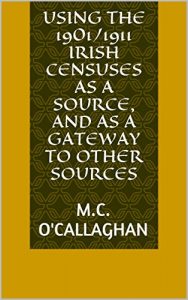The author had three aims in writing this book. The first aim was to inform readers about the surprising amount of information in the 1901 and 1911 Irish Censuses, which are freely available on the internet at www.census.nationalarchives.ie. For instance, you can find out the number of outhouses that your relations had, and the class of house they had.
The second aim was to show the many ways in which you can look at information in the census. For instance, you can compare the lives of your great-grandparents, perhaps bringing up their young children at the time of the censuses, and the lives of your great-great-grandparents, perhaps in old age at the time of the censuses. You can look at all the people in a town, and maybe list the number of people with different occupations, note the percentage that could not read or write, and so on.
The third aim was to make Irish genealogy as a whole more accessible and user-friendly, by showing readers how they can use the 1901/1911 Censuses as a gateway source leading out towards other sources.
There are lots of sources of information now available to someone who wants to find out about their Irish genealogy, sources such as educational or military records. These sources, whilst great news for those doing research, can also be a little overwhelming. Where do you start? How does everything link together? The 1901/1911 Censuses can help. If the censuses are used as a central source, they can be your guide. They can point you in a straightforward, natural way towards other sources. For instance, if the censuses suggest that someone in your family died, this points you in the direction of civil (government) and parish death records. Chapter 7 tells you where birth, marriage and death records can be found, and what to expect from them.
There are lots of other directions in which the censuses might lead you. If someone in your family had a particular occupation, this can lead to certain sources. If you think a census relation emigrated, or was in court, or in the newspapers, this too can lead you to different sources. Perhaps a census relation participated in a major historical event, or was a prominent person; again, there are sources that you can search. Chapter 8 notes such sources, describing where they can be found.
To sum up, the author's intention in this book is to help readers to make the most of the 1901 and 1911 Census records, and to tell them about the other sources to which the censuses can lead.
The book contains about 20,400 words.
The author has written thirteen other books, all of which are available on Amazon.
The second aim was to show the many ways in which you can look at information in the census. For instance, you can compare the lives of your great-grandparents, perhaps bringing up their young children at the time of the censuses, and the lives of your great-great-grandparents, perhaps in old age at the time of the censuses. You can look at all the people in a town, and maybe list the number of people with different occupations, note the percentage that could not read or write, and so on.
The third aim was to make Irish genealogy as a whole more accessible and user-friendly, by showing readers how they can use the 1901/1911 Censuses as a gateway source leading out towards other sources.
There are lots of sources of information now available to someone who wants to find out about their Irish genealogy, sources such as educational or military records. These sources, whilst great news for those doing research, can also be a little overwhelming. Where do you start? How does everything link together? The 1901/1911 Censuses can help. If the censuses are used as a central source, they can be your guide. They can point you in a straightforward, natural way towards other sources. For instance, if the censuses suggest that someone in your family died, this points you in the direction of civil (government) and parish death records. Chapter 7 tells you where birth, marriage and death records can be found, and what to expect from them.
There are lots of other directions in which the censuses might lead you. If someone in your family had a particular occupation, this can lead to certain sources. If you think a census relation emigrated, or was in court, or in the newspapers, this too can lead you to different sources. Perhaps a census relation participated in a major historical event, or was a prominent person; again, there are sources that you can search. Chapter 8 notes such sources, describing where they can be found.
To sum up, the author's intention in this book is to help readers to make the most of the 1901 and 1911 Census records, and to tell them about the other sources to which the censuses can lead.
The book contains about 20,400 words.
The author has written thirteen other books, all of which are available on Amazon.






